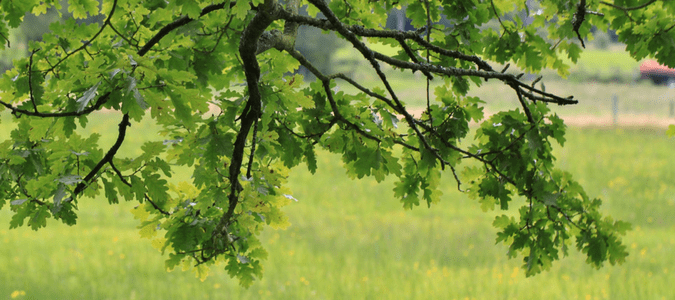
There are many reasons why trees, especially mature trees, raise the property value of your home. Trees provide majestic beauty and undeniable curb appeal, along with much-needed shade in the Texas heat. They enable us to stay out of the sun as we relax outdoors, and they also provide both shelter and food for many varieties of animals and insects.
Trees that aren’t well maintained, however, can become not only an eyesore, but also an actual liability. Homeowners who don’t maintain their trees risk injury and property damage due to fallen limbs, termites, tree diseases and other hazards. That’s why pruning your trees—trimming away dead or overgrown branches—is essential to maintaining the trees’ longevity, beauty and value.
Pruning trees isn’t only for purposes of increased safety, health or value, either. While pruning branches helps to prevent the overgrowth of tree limbs, it also improves the overall health of the tree by encouraging new growth—but only when done properly.
Even savvy homeowners sometimes don’t know the best time to prune trees in Texas or the best techniques to use. Should you prune on an annual or semi-annual basis, or simply as needed? Should you prune in specific seasons—perhaps every winter, before new growth occurs, or after late-summer storms, when high winds and heavy rains may have damaged the integrity of the branches? Do you need a chainsaw, a pruning saw or some other tool?
Read on to find out the best time to prune trees in Texas and learn proper pruning techniques that will help you maintain the optimal health and value of your trees.
When Is the Best Time to Prune Trees in Texas?
In the wilderness, trees have no need for pruning, and certainly not on any schedule. Wild animals, wind and precipitation, as well as the ongoing growth of surrounding trees and other vegetation, provide all the natural pruning necessary on a year-round basis.
Around our homes, on the other hand, pruning trees is an important part of responsible homeownership. Knowing when is the best time to prune trees in Texas is the first step toward taking good care of your valuable trees.
Most Texas trees should be pruned during the coldest months of the year—in most parts of Texas, that’s January and February—when the tree is in the dormant part of its growth cycle. Pruning trees when they’re dormant helps the cut wounds heal faster, reducing the risk of disease and insect infestation.
To get a little more specific about the best times to prune certain varieties of Texas trees, late winter is the best time to prune Texas trees that are either non-blooming or summer-blooming. This includes crepe myrtles and many other varieties prevalent in many Texas yards. Trees that bloom in spring, on the other hand, such as mountain laurels and redbuds, should be pruned immediately after they bloom (while still as early in the season as possible).
Although it’s perfectly safe and appropriate to prune trees any time of year in our region, there are two major exceptions. If you have oaks, which are widespread across Texas, trimming is only recommended from July until January, for reasons we will explore in more depth below.
The other big exception to the rule of pruning in winter (or early spring) is for homeowners who live in areas of Texas that are prone to severe weather. High winds and heavy, icy precipitation can wreak havoc even on the strongest, most well-established trees. It’s better to trim away dead or overgrown branches in the wrong season than to leave them on your trees before storm season hits.
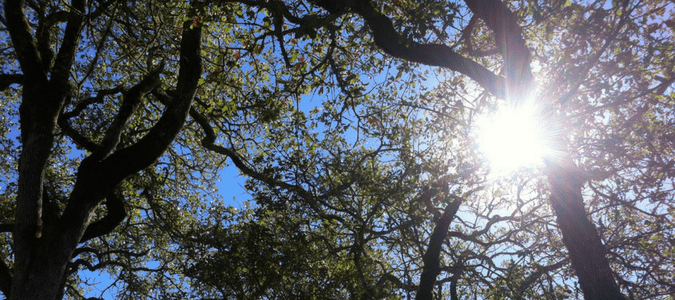
The Best Time to Prune Oak Trees in Texas
If the official Texas State Tree weren’t the pecan, it would probably be an oak tree. With over fifty varieties native to Texas, oak trees are plentiful and beloved in our great state. Live oaks, Spanish oaks, Mexican oaks, red oaks, bur oaks, post oaks and more stretch their graceful canopies to provide beauty, shade and shelter for us to relax and enjoy the outdoors.
If you’ve ever heard of oak wilt, then you already know this dreaded disease is serious for oak trees and the homeowners and landscapers who love them. Affecting mostly live oaks and red oaks, oak wilt is a fungus that is spread by beetles, and it can kill an oak tree over time. Worse yet, the fungus can spread to surrounding trees, especially if you choose the wrong time to prune or remove a diseased tree.
For these reasons and more, keeping your oak trees pruned is vital to their health as well as to the proper care and maintenance of your home and property. So when is the best time to prune oak trees in Texas?
Like most other trees in Texas, healthy oak trees are best pruned during winter months. Oak trees suffering from diseases like oak wilt, however, may require a different pruning schedule along with very careful treatment. Trees affected by oak wilt can be pruned in the heat of summer, but should never be pruned in the spring. Springtime is when oak trees are the most prone to contracting oak wilt, so pruning should be avoided during this season if possible.
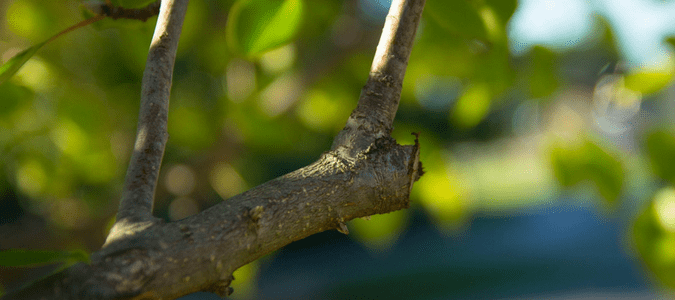
Proper Pruning Techniques for Texas Trees
Preventing the spread of oak wilt is just one of many reasons it’s important to utilize proper pruning techniques for Texas trees, but it’s certainly not the only one. When a tree limb is cut and removed, it creates a wound on the tree that takes time to heal—and improper pruning can create wounds that never heal correctly.
The first thing any homeowner should know before pruning their trees is to avoid cutting into the tree’s branch collar. The branch collar is the thicker, raised ring at the base of a limb where it connects with the tree trunk or with a larger, “parent” branch. Inexperienced tree pruners might think it’s best to prune limbs flush with the trunk, but this is a mistake. The branch collar is a vital part of the tree’s circulation system. If you cut into the collar when pruning a limb, it can interfere with the tree’s ability to circulate nutrients, prevent the wound from healing properly, and leave the tree vulnerable to bacteria and disease.
When pruning branches, be sure to clean and sterilize your tools, including pruning saws, shears or any other tools that you use. Cleaning your tools with bleach before you work on each new branch or tree helps prevent the spread of bacteria and disease from one tree to another.
Pruning shears can be used on very small growths, while hand-held pruning saws can be used on smaller or larger branches. For significantly larger limbs, a chainsaw may be necessary. Smaller limb pruning and light tree shaping can be done at any time of year, and since the cuts and resulting wounds are smaller, proper timing and technique aren’t as critical.
When you’re pruning larger branches, however, proper pruning timing and techniques are especially important. To avoid improper healing of a pruned limb, it’s best to make not just one cut through the limb that is to be pruned, but three:
- Make a small notched cut in the bottom of the limb to be pruned, a couple of feet out from the branch collar. This notch should extend only about a quarter of the way through the branch; its purpose is to keep the bark from splitting when the whole limb is cut.
- Just past that notch (moving in the direction of the end of the branch), make a second, complete cut through the entire limb. This is referred to as a relief cut, as it removes the bulk of the limb’s weight, enabling you to make your final cut without splitting any healthy wood or bark in the process.
- Finally, make a third, complete cut through the limb, just past the branch collar, where the collar gives way to the newly shortened branch. Often, it’s best to make this cut from the bottom up, especially if your saw can’t cut at the proper angle when fitted in the crotch of the branch at the top.
Be sure that when pruning any type of trees, you don’t trim away more than one-quarter of the tree’s branches at any one time. Overly vigorous pruning can cause stress to the tree and damage its circulatory system, leaving it vulnerable to pests and disease.
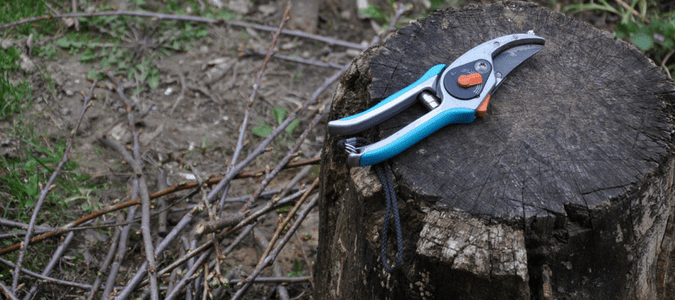
Best Techniques for Trimming Oak Tree Branches
We’ve established that trimming the branches of your oak trees, and any trees on your property, helps enhance and preserve their beauty along with their overall health and value. Trimming your oak trees is also an important safety measure for responsible homeowners, as it reduces the likelihood of falling limbs that could damage your home, vehicle or other property.
The best techniques for trimming oak tree branches include the proper pruning techniques mentioned above, along with a few special steps that are important to note. When oak wilt or other disease is suspected, it’s especially important to sterilize your pruning saws and other tools before working on each new oak tree. As mentioned earlier, cleaning your tools with a bleach solution will help prevent the spread of disease from an unhealthy oak tree to a healthy one. Using special fungicides on the wounds when pruning a tree with oak wilt can also help extend the life of the tree and prevent the spread of disease. Finally, be sure to burn, chip or bury any trimmed branches or other debris from trees affected by oak wilt as soon as possible after pruning to help prevent the spread of this deadly fungus.
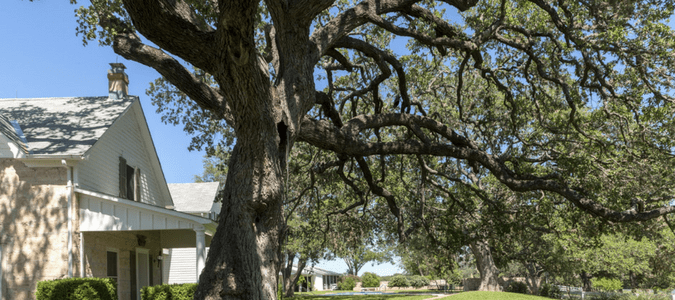
How to Trim an Oak Tree Without Killing It
Some common mistakes people make when pruning their oak trees include cutting branches too short and neglecting to make relief cuts—removing the bulk of a branch’s weight to prevent splitting before making the final pruning cut. Both of these mistakes leave oak trees vulnerable to disease, rot and insect infestation, which can harm the trees’ health, longevity and value.
This is why some DIY tree trimmers, and even some arborists, paint the cut surfaces of pruned tree limbs with wound dressing or latex paint (also called pruning paint). However, many tree experts actually believe that using pruning paint is a mistake. Research shows that sealing tree wounds after pruning can seal in both moisture and bacteria, inhibiting the tree’s natural healing ability and leaving it prone to disease.
One exception is in the case of oak trees that are suffering from oak wilt. Some experts believe that when it comes to preventing the spread of oak wilt, the benefits of pruning paint outweigh the negative effects. In this case, painting the wounds may be necessary after trimming branches from a tree affected by this fungus to reduce the chances that other nearby trees might become affected as well.
Generally speaking, however, pruning paint is not needed, as trees have their own natural healing processes. When healthy oak tree branches are pruned properly and in the correct season, over time, the tree will form calloused wood at the wound site. This “scar” is all the healing needed to keep the tree healthy and strong. This applies to all trees, in fact, not just oaks.
Trust Your Trees to ABC
By using the tips and techniques in this post, Texas homeowners can keep their trees vigorous, healthy and beautiful for many years to come. If you don’t have the time, skills or tools to preserve the value of your trees, let the experienced and skilled specialists at ABC Home & Commercial Services take care of your tree care and trimming. Not only do our tree pros know when and how to prune trees, but also they can advise you on the best trees to plant on your property and how to take care of them all year long.
